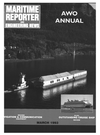
Page 89: of Maritime Reporter Magazine (March 1993)
Read this page in Pdf, Flash or Html5 edition of March 1993 Maritime Reporter Magazine
Norcontrol Signs $ 1.67
Million Contract To Deliver
Marine Simulators
The Shipping and Transport Col- lege in Rotterdam recently signed a contract to have Norway-based
Norcontrol deliver an engine room and cargo handling simulator, worth a reported $1.67 million. The college already owns seven simulators.
The simulators will be used for students of the college as well as for update courses for ship officers.
The engine room simulator will be installed with software for both a large, long-stroke diesel (B&W 5L90
MC) and a medium-speed diesel (Pielstick PC4 10 cyl.).
With the cargo handling simula- tor, loading and discharging can be trained under varying circum- stances, and the effects of an ill- distributed load on a vessel can be shown. Both simulators are sched- uled to be installed and operational by September 1993.
For more information on
Norcontrol simulators,
Circle 24 on Reader Service Card
Robbins Manufacturing
Features Full Line
Of Quality Fasteners
Robbins Manufacturing produces virtually any precision stainless steel or non-ferrous fastener or special part suitable for production by the cold-heading process.
The company's primary product is a full line of hex head cap screws in 18-8 and 316 stainless steel, in a wide range of diameters and lengths, in coarse and fine threads, and with standard or full threads. The prod- uct is manufactured to meet ANSI/
ASME/IFIB 18.2.1, is fully traceable and always in stock.
Other products include pentagon head cap screws, torque head bolts, clipped head bolts, buss bar bolts, valve stems and studs, as well as parts requiring special head dimen- sions, point configurations, nonstan- dard thread lengths and types, and unique washer and shank designs.
For additional information on
Robbins Manufacturing's products, service or quality standards,
Circle 111 on Reader Service Card
Automatic Welding With Sensors
Developed By Daewoo
Daewoo Shipbuilding & Heavy
Machinery Ltd. has produced what is reported to be the world's first automatic line welding apparatus, featuring optic sensors, which can be applied to shipbuilding and heavy industries.
The new invention is said to in-
March, 1993 crease productivity 50 times over previous systems.
Although line welding systems have utilized robots and other equipment on electronics and auto- mobile production lines, the cost of developing such systems for small order, diversified shipbuilding and heavy industry production lines has been prohibitive.
This new system, developed over two years by the Automatic Welding
Research Team at Daewoo
Shipbuilding's Technical Center, now makes automatic welding avail- able to these industries.
It is the product of intensive tech- nical expertise accumulated over the last ten years of operations at
Daewoo's Okpo Shipyard & Indus- trial Complex. The research team developed special new welding rods for the process, and the optic sensors guarantee complete accuracy, dura- bility, convenience and safety in weld- ing.
Three months of intensive on-site testing, using 60 welding machines, proved the efficiency and perfor- mance of the new system.
IMA IMPACT OF FLEET DOWNSIZING ON THE ECONOMICS OF NAVY SHIP MAINTENANCE
Report No. 7123 - March 1993 $1,200 per copy
A new 200+ page report from IMA examines the critical issues shaping future downsizing of the naval ship repair industrial base. Included is a projection of capacity supply and demand — and a detailed economic analysis of rationalization options. The report is an invaluable reference for anyone interested in the current round of base closure decisions. /. EXECUTIVE SUMMARY o Future fleet size and composition o Long term maintenance requirements o Available maintenance capacity o Projected ship repair surplus o Economics of rationing vs. closure o Assessment of Navy options 2. THE FUTURE NAVY FLEET o Drivers shaping future Navy requirements o Current fleet downsizing plan o Potential acceleration of fleet downsizing o Likely future fleet size and composition 3. PROJECTED MAINTENANCE REQUIREMENTS o Planned surface ship job starts o Planned submarine job starts o Impact of accelerated fleet downsizing o Likely long term maintenance forecast 4. A VAILABLEMAINTENANCE CAPACITY o Naval shipyards o Commercial ship repair yards o Trident refits, SRF's, SIMA's, tenders o Foreign yards regularly used by Navy
SURPLUS REDUCTION REQUIREMENTS o Scheduled requirements vs. available capacity o Requirement for handling emergent work o Projected nuclear repair surplus o Projected conventional repair surplus
ECONOMICS OF RA TIONING VS. CLOSURE o Current policy for dealing with surplus capacity o Cost structure of shipyards o Fixed costs — and economics of facility utilization o Cost to Navy of spreading available work o Impact of rationing on future industrial base o Impact on operational and strategic requirements
SHIPYARD RATIONALIZATION o Need to rationalize available capacity o Hazards of relying on competition o Identifying and preserving top facilities o Channeling critical workmass to these facilities
Appendices o Cost details for naval shipyards o Details for 1991 base closure evaluation
To order report number 7123, Impact of Fleet Downsizing on the Economics of Navy Ship
Maintenance, please contact: IMA Associates, Inc. — 600 New Hampshire Ave., NW— Suite 140 .. Washington, DC 20037- Telephone (202) 333-8501 - Fax (202) 333-8504. Telephone or telefax orders will be accepted.
Circle 312 on Reader Service Card 101

 88
88

 90
90
